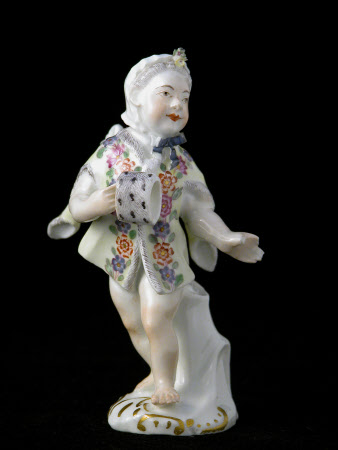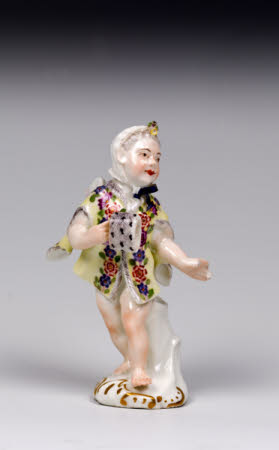Figure
Furstenberg
Category
Ceramics
Date
circa 1772 - circa 1773
Materials
Hard paste porcelain
Measurements
8 x 2 cm
Place of origin
Germany
Order this imageCollection
Saltram, Devon
NT 870958
Summary
Figure of an Amorini or cupid. A moulded figure of a winged cupid dressed in a dormeuse (muslin cap) and toile (a short cloth to cover the shoulders) and holding a fur muff. Hard paste porcelain produced at the Furstenberg factory, Germany. Round label underneath 319 The Saltram Collection (1967): No 265T, p.60
Full description
In the mid-eighteenth century, the dessert tables of English aristocrats were often decorated with small porcelain sculptures of amorini in delightful disguises, identified as Cupid, Venus or simply 'loves in disguises.' depending on their gender. These semi-erotic, coquettish figures were probably inspired by a painting of 1728 by Charles Antoine Coypel of partially clothed children masquerading as adults, satirising the vanity of the French court in their performance of the Toilette. The painting, acquired by Madame de Pompadour in 1750 was circulated through an engraving by Francois-Bernard Lepicie, Jeu d'enfans, published in Paris in 1731. Other sets of similar figures were designed representing street traders or courtiers. The figures were apparently modelled at Meissen by Johann Joachim Kandler (1706-75) between 1749 and 1755 when copied made at Chelsea were first recorded. They were probably intended for the French market. These popular Meissen figures were copied by other factories across Europe, including at Furstenberg where this one was made. Adapted from 'Ceramics: 400 Years of British Collecting in 100 Masterpieces' by Patricia Ferguson, 2016.
Provenance
At Saltram by 1951 and accepted by HM Treasury in lieu of full payment of Estate Duty from the Executors of Edmund Robert Parker (1877-1951), 4th Earl of Morley
Marks and inscriptions
Crossed swords of Meissen in underglaze blue on reverse, centre
Makers and roles
Furstenberg, manufacturer
References
The Saltram Collection (1967):, No. 265 T, p.60

